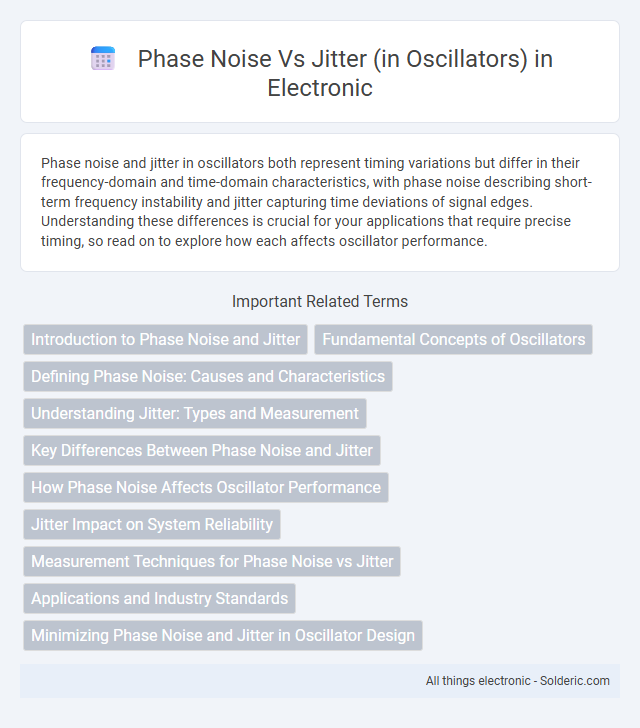Phase noise and jitter in oscillators both represent timing variations but differ in their frequency-domain and time-domain characteristics, with phase noise describing short-term frequency instability and jitter capturing time deviations of signal edges. Understanding these differences is crucial for your applications that require precise timing, so read on to explore how each affects oscillator performance.
Comparison Table
| Parameter | Phase Noise | Jitter |
|---|---|---|
| Definition | Random fluctuations in the phase of an oscillator's output signal. | Time-domain variation of signal transitions from their ideal positions. |
| Units | dBc/Hz (decibels relative to carrier per Hertz) | Seconds (typically picoseconds or femtoseconds) |
| Measurement Domain | Frequency domain | Time domain |
| Impact | Degrades spectral purity and causes signal spreading. | Leads to timing errors affecting data integrity and synchronization. |
| Typical Use | Characterize oscillator spectral quality. | Assess timing stability in digital systems. |
| Cause | Noise sources like thermal noise, flicker noise within oscillator circuits. | Clock signal timing variation caused by phase noise and jitter sources. |
| Relation | Phase noise results in jitter through time-domain conversion. | Derived from phase noise integrating over frequency. |
Introduction to Phase Noise and Jitter
Phase noise in oscillators refers to the random fluctuations in the phase of the output signal, which appear as spectral spreading around the carrier frequency. Jitter describes the timing variations or deviations in signal edges, often derived from phase noise when viewed in the time domain. Understanding the relationship between phase noise and jitter is crucial for optimizing oscillator performance in communication systems, ensuring signal integrity in your designs.
Fundamental Concepts of Oscillators
Phase noise represents the short-term frequency fluctuations in oscillators, characterized by spectral spreading around the carrier frequency, whereas jitter refers to the time-domain variation of signal edges caused by these phase disturbances. Fundamental concepts of oscillators involve understanding resonant frequency stability, quality factor (Q), and noise sources such as thermal and flicker noise, which directly impact phase noise and subsequently jitter performance. Effective oscillator design aims to minimize phase noise to ensure precise timing and reduced jitter in communication and signal-processing applications.
Defining Phase Noise: Causes and Characteristics
Phase noise in oscillators refers to rapid, short-term fluctuations in the phase of a signal, typically arising from thermal noise, device imperfections, and power supply variations. It manifests as a spectral spreading around the oscillator's carrier frequency, degrading signal purity and increasing bit error rates in communication systems. Understanding phase noise is essential for minimizing jitter, which represents the time-domain variation of the signal's zero-crossings and directly impacts the timing precision in your applications.
Understanding Jitter: Types and Measurement
Jitter in oscillators refers to the timing variations of signal edges, commonly categorized into random jitter (RJ), deterministic jitter (DJ), and total jitter (TJ), each affecting signal integrity differently. Measurement techniques utilize time interval analyzers, phase noise analyzers, and sampling oscilloscopes to quantify jitter, often by converting phase noise data into time-domain jitter metrics. Accurate jitter characterization enables optimization of oscillator performance in communication systems by minimizing bit error rates and maintaining signal fidelity.
Key Differences Between Phase Noise and Jitter
Phase noise in oscillators refers to the rapid, short-term fluctuations in the phase of the signal's waveform, typically analyzed in the frequency domain as spectral density measured in dBc/Hz. Jitter, on the other hand, represents the time domain variation of signal timing, commonly quantified as root mean square (RMS) or peak-to-peak timing error. The key difference lies in phase noise describing frequency domain phase instabilities, while jitter directly measures timing deviations critical for digital signal integrity.
How Phase Noise Affects Oscillator Performance
Phase noise in oscillators manifests as random fluctuations in the phase of the output signal, directly contributing to signal jitter and degrading the timing accuracy in high-frequency applications. High phase noise leads to increased spectral spreading around the oscillator's carrier frequency, resulting in reduced signal purity and impaired system performance in communications and radar systems. Minimizing phase noise is crucial for enhancing oscillator stability, improving bit error rates in digital communications, and achieving precise frequency synthesis.
Jitter Impact on System Reliability
Jitter, which represents the temporal variation of an oscillator's signal edges, directly impacts system reliability by causing timing errors and data corruption in communication and control systems. Elevated jitter levels lead to degraded signal integrity, increasing the likelihood of synchronization failures and reducing overall system performance. Managing jitter is essential to ensure robust and predictable operation of high-speed digital and RF systems in your applications.
Measurement Techniques for Phase Noise vs Jitter
Phase noise measurement in oscillators typically involves spectrum analyzers or phase noise analyzers that quantify frequency-domain noise close to the carrier by analyzing single-sideband noise power density. Jitter measurement uses time-domain instruments like oscilloscopes with histogram analysis to evaluate timing variations over multiple cycles, often employing time-interval analyzers or sampling scopes for precision. Cross-correlation and signal averaging techniques enhance measurement sensitivity and accuracy for both phase noise and jitter, enabling detailed characterization of oscillator stability.
Applications and Industry Standards
Phase noise and jitter critically impact oscillator performance in telecommunications, radar, and precision measurement systems, where low phase noise ensures signal purity and minimal jitter guarantees timing accuracy. Industry standards such as IEEE 1588 for time synchronization and ITU-T G.8251 define acceptable jitter and phase noise levels to maintain system reliability and interoperable network timing. Your system's design must prioritize adherence to these standards to optimize oscillator stability and overall signal integrity.
Minimizing Phase Noise and Jitter in Oscillator Design
Minimizing phase noise and jitter in oscillator design requires using low-noise active devices and high-quality factor resonators to reduce signal distortion and frequency instability. Careful layout techniques, such as shielding and grounding, help mitigate electromagnetic interference and crosstalk that contribute to noise. Implementing power supply filtering and temperature compensation further stabilizes the oscillator's output, enhancing overall signal purity and timing accuracy.
phase noise vs jitter (in oscillators) Infographic

 solderic.com
solderic.com